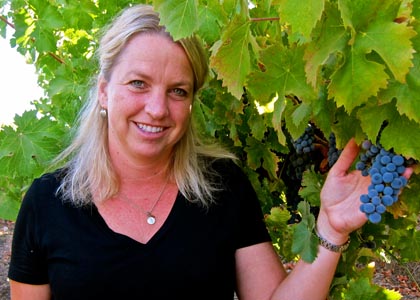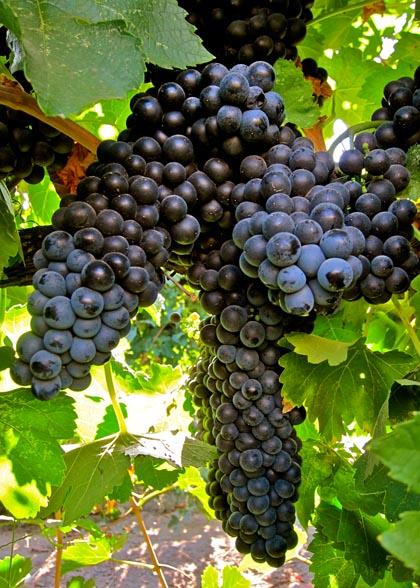Letters from Lodi
An insightful and objective look at viticulture and winemaking from the Lodi
Appellation and the growers and vintners behind these crafts. Told from the
perspective of multi-award winning wine journalist, Randy Caparoso.
Lodi’s “perfect storm” in 2011
m2 Wines' Muriah Grabner picking Soucie Vineyard Zinfandel -- a Mokelumne River AVA classic -- on September 23
“Forecast calls for rain, but local grape growers aren’t panicking,” reads the headline in today’s Lodi News-Sentinel. In fact, vintners are thinking the opposite: their outlook on the 2011 Lodi harvest thus far is positively positive — as if the skies were still crystal blue and absolutely cloudless.
m2 winemaker/proprietor Layne Montgomery measuring Brix of fermenting 2011 Zinfandel
It all comes down to grapes: the varieties that are most susceptible to bunch rot – Zinfandel, Chardonnay and Pinot Noir (yes, Lodi grows a significant quantity of Pinot Noir, too) – are pretty much all picked as of today. As much as an inch of rain is expected to fall during a 12-15 hour window starting tonight (October 4) and through most of Wednesday. Even so, thicker skinned grapes like Cabernet Sauvignon and Merlot will remain on the vine in anticipation, and hopes, that the sunnier weather forecast for the second half of the week will continue to take grapes through a positive ripening process, lasting all the way through the end of October.
So far at least, 2011 has been a “perfect storm,” according to the multi-tasking winemaker, Chad Joseph (consulting for Harney Lane, Sorelle, Harmony Wynelands, Valhalla, McConnell Estates and McCormack-Williamson). “The wet spring lowered yields,” says Joseph, “and the cooler summer delayed ripening. But when the heat finally hit, the vines were healthy and ready to produce sugar. Things took off since the vines weren’t carrying a heavy crop load, and we ended up with nicely balanced grapes.
“The low yields seem to have allowed grapes the opportunity to concentrate sugars through natural ripening, and the acid levels are good since there was never really was heat stress to shut down the vines. I’m really happy with the wines we have pressed so far, which is mostly whites and Zinfandel.”
Borra Vineyards winemaker Markus Niggli is even more enthusiastic; telling us, “cold spring and cool summer with light crop created almost perfect crop. We picked Zinfandel at 1.5 tons per acre that was absolutely mind blowing in quality – very concentrated and rich.” In fact, says Niggli, 2011 Zinfandel looks “similar to 2010,” which many vintners have called the finest in memory.
Van Ruiten Family winemaker Ryan Leeman reports that “Chardonnay, Pinot Grigio, and Viognier reach full ripeness this year by early to mid-September. The whites are carrying more acid this year, and 2011 will likely be the first time they will go through complete malolactic fermentation” – the latter factor, indicative of the higher than usual acid levels.
Just-picked 2011 Soucie Vineyard Zinfandel
Insofar as reds, according to Leeman, “just about all the Zinfandel has been harvested.” This year Leeman also fermented 28 tons of old vine Zinfandel with native yeasts – utilizing natural flora on skins rather than inoculating with laboratory yeasts – which has just about completed primary fermentation. The native yeast fermented Zinfandel is looking so good, according to Leeman, it will definitely “be something we’ll continue in the future.”
But if the rains persist, Leeman tells us, “it will become a winemaker’s year” – meaning, quality will suddenly be determined by the skill of individual winemakers, as opposed to the largesse of Nature.
Joan Kautz with Kautz Family Cabernet Franc; which, like most Bordeaux grapes in Lodi and the rest of California, will hang through the rain for further ripening
Adds Joseph, “at Sorelle we decided to pick Sangiovese and Barbera before the rain since the Brix (i.e. sugar readings) were almost there and we didn’t want to risk potential breakdown incurred by weather. But at Harney Lane, the Tempranillo and Petite Sirah are just not ready – for the lush, rich style we produce. We are waiting for the acid to drop or tannins to ripen. So for now, we are riding it out.”
Ripken Petite Sirah will be picked following the rains, later in October
Niggli concurs with Joseph: “Hopefully the rain will not damage too much crop. Petite Sirah has been hanging nicely, but is slow to ripen. We may pick our Barbera later this week, and Merlot right behind it. Syrah, Cabernet Sauvignon and Petite Sirah are more like two weeks down the road.”
Speaking as both a grower and winemaker, Niggli is optimistic about the Lodi wine industry’s economic future: “We are experiencing another great year in terms of quality – the growing conditions have been outstanding. But with the low yields, demand for 2012 will increase grape prices in Lodi,” which will be good for growers. “Buying grapes at an early stage will be the key for next year.”
Speaking as a winemaker in pursuit of higher levels of quality on a pure sensory level – as a way of growing the reputation of the Lodi AVA, and through that, demand for its grapes – Joseph shares some interesting insights: “I’m still trying to define what balance is in the context of style. You’ve got to give them (Lodi wine drinkers) what they want, and still maximize what you’re given. We are doing more indigenous (i.e. natural or “wild” yeast) fermentations on the Zinfandel, and fermenting some whites even colder.”
Says Joseph, “I am also trying to understand the relevance of texture as an important component to a wine’s profile – so much has been about flavor, texture seems to be overlooked a little in the context of balance, structure, and most importantly, terroir” – that is to say, the qualities that might ultimately distinguish Lodi as a region producing wines unique to Lodi.
Ultimate quality, after all, is not simply a matter of growing wines that are as good as those from other regions. It’s also a matter of producing wines of special attributes that can come only from Lodi; which is entirely possible, given the “perfect storm” of talent, determination and wherewithal we are seeing here in Lodi, even as we speak.
Soucie Vineyard grape picker





